Interventions for preventing venous thromboembolism in adults undergoing knee arthroscopy
- PMID: 35993965
- PMCID: PMC9394584
- DOI: 10.1002/14651858.CD005259.pub5
Interventions for preventing venous thromboembolism in adults undergoing knee arthroscopy
Abstract
Background: Knee arthroscopy (KA) is a routine orthopedic procedure recommended to repair cruciate ligaments and meniscus injuries and, in suitable cases, to assist the diagnosis of persistent knee pain. There is a small risk of thromboembolic events associated with KA. This systematic review aims to assess if pharmacological or non-pharmacological interventions may reduce this risk. This is an update of an earlier Cochrane Review.
Objectives: To evaluate the efficacy and safety of interventions - whether mechanical, pharmacological, or a combination of both - for thromboprophylaxis in adults undergoing KA.
Search methods: We used standard, extensive Cochrane search methods. The latest search date was 1 June 2021.
Selection criteria: We included randomized controlled trials (RCTs) and controlled clinical trials (CCTs), blinded or unblinded, of all types of interventions used to prevent deep vein thrombosis (DVT) in men and women aged 18 years and older undergoing KA.
Data collection and analysis: We used standard Cochrane methods. Our primary outcomes were pulmonary embolism (PE), symptomatic DVT, asymptomatic DVT, and all-cause mortality. Our secondary outcomes were adverse effects, major bleeding, and minor bleeding. We used GRADE criteria to assess the certainty of the evidence.
Main results: We did not identify any new studies for this update. This review includes eight studies involving 3818 adults with no history of thromboembolic disease. Five studies compared daily subcutaneous low-molecular-weight heparin (LMWH) versus no prophylaxis; one study compared oral rivaroxaban 10 mg versus placebo; one study compared daily subcutaneous LMWH versus graduated compression stockings; and one study compared aspirin versus no prophylaxis. The incidence of PE in all studies combined was low, with seven cases in 3818 participants. There were no deaths in any of the intervention or control groups. Low-molecular-weight heparin versus no prophylaxis When compared with no prophylaxis, LMWH probably results in little to no difference in the incidence of PE in people undergoing KA (risk ratio [RR] 1.81, 95% confidence interval [CI] 0.49 to 6.65; 3 studies, 1820 participants; moderate-certainty evidence). LMWH may make little or no difference to the incidence of symptomatic DVT (RR 0.61, 95% CI 0.18 to 2.03; 4 studies, 1848 participants; low-certainty evidence). It is uncertain whether LMWH reduces the risk of asymptomatic DVT (RR 0.14, 95% CI 0.03 to 0.61; 2 studies, 369 participants; very low-certainty evidence). LMWH probably makes little or no difference to the risk of all adverse effects combined (RR 1.85, 95% CI 0.95 to 3.59; 5 studies, 1978 participants; moderate-certainty evidence), major bleeding (RR 0.98, 95% CI 0.06 to 15.72; 1451 participants; moderate-certainty evidence), or minor bleeding (RR 1.79, 95% CI 0.84 to 3.84; 5 studies, 1978 participants; moderate-certainty evidence). Rivaroxaban versus placebo One study with 234 participants compared oral rivaroxaban 10 mg versus placebo. There were no cases of PE reported. Rivaroxaban probably led to little or no difference in symptomatic DVT (RR 0.16, 95% CI 0.02 to 1.29; moderate-certainty evidence). It is uncertain whether rivaroxaban reduces the risk of asymptomatic DVT because the certainty of the evidence is very low (RR 0.95, 95% CI 0.06 to 15.01). The study only reported bleeding adverse effects. No major bleeds occurred in either group, and rivaroxaban probably made little or no difference to minor bleeding (RR 0.63, 95% CI 0.18 to 2.19; moderate-certainty evidence). Aspirin versus no prophylaxis One study compared aspirin with no prophylaxis. There were no PE, DVT or asymptomatic events detected in either group. The study authors reported adverse effects including pain and swelling, but without clarifying which groups these occurred in. There were no bleeds reported. Low-molecular-weight heparin versus compression stockings One study with 1317 participants compared LMWH versus compression stockings. LMWH may lead to little or no difference in the risk of PE compared to compression stockings (RR 1.00, 95% CI 0.14 to 7.05; low-certainty evidence), but it may reduce the risk of symptomatic DVT (RR 0.17, 95% CI 0.04 to 0.75; low-certainty evidence). It is uncertain whether LMWH has any effect on asymptomatic DVT (RR 0.47, 95% CI 0.21 to 1.09; very low-certainty evidence). The results suggest LMWH probably leads to little or no difference in major bleeding (RR 3.01, 95% CI 0.61 to 14.88; moderate-certainty evidence), or minor bleeding (RR 1.16, 95% CI 0.64 to 2.08; moderate-certainty evidence). We downgraded the certainty of the evidence for imprecision due to overall small event numbers, for risk of bias due to concerns about lack of blinding, and for indirectness due to uncertainty about the direct clinical relevance of asymptomatic DVT detection.
Authors' conclusions: There is a small risk that healthy adults undergoing KA will develop venous thromboembolism (PE or DVT). We found moderate- to low-certainty evidence of little or no benefit from LMWH, or rivaroxaban in reducing this small risk of PE or symptomatic DVT. The studies provided very low-certainty evidence that LMWH may reduce the risk of asymptomatic DVT compared to no prophylaxis, but it is uncertain how this directly relates to incidence of DVT or PE in healthy people undergoing KA. There is probably little or no difference in adverse effects (including major and minor bleeding), but data relating to these outcomes were limited by low numbers of events in the studies reporting these outcomes.
Copyright © 2022 The Cochrane Collaboration. Published by John Wiley & Sons, Ltd.
Conflict of interest statement
CP: none JC: declared that he has received payment for consultancy from Smith and Nephew, Inc. This was unrelated to this review. GB: none JR: declared an affiliation to the
Figures
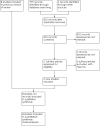
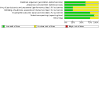
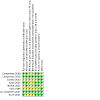
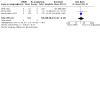
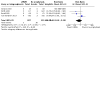
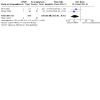
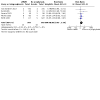
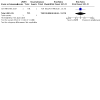
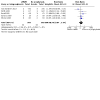

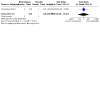
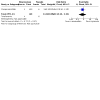

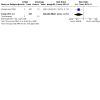
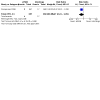
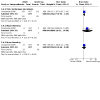
Update of
-
Interventions for preventing venous thromboembolism in adults undergoing knee arthroscopy.Cochrane Database Syst Rev. 2020 May 6;5(5):CD005259. doi: 10.1002/14651858.CD005259.pub4. Cochrane Database Syst Rev. 2020. Update in: Cochrane Database Syst Rev. 2022 Aug 22;8:CD005259. doi: 10.1002/14651858.CD005259.pub5. PMID: 32374919 Free PMC article. Updated.
Similar articles
-
Interventions for preventing venous thromboembolism in adults undergoing knee arthroscopy.Cochrane Database Syst Rev. 2020 May 6;5(5):CD005259. doi: 10.1002/14651858.CD005259.pub4. Cochrane Database Syst Rev. 2020. Update in: Cochrane Database Syst Rev. 2022 Aug 22;8:CD005259. doi: 10.1002/14651858.CD005259.pub5. PMID: 32374919 Free PMC article. Updated.
-
Pharmacological interventions for preventing venous thromboembolism in people undergoing bariatric surgery.Cochrane Database Syst Rev. 2022 Nov 22;11(11):CD013683. doi: 10.1002/14651858.CD013683.pub2. Cochrane Database Syst Rev. 2022. PMID: 36413425 Free PMC article.
-
Direct factor Xa inhibitors versus low molecular weight heparins or vitamin K antagonists for prevention of venous thromboembolism in elective primary hip or knee replacement or hip fracture repair.Cochrane Database Syst Rev. 2025 Jan 27;1(1):CD011762. doi: 10.1002/14651858.CD011762.pub2. Cochrane Database Syst Rev. 2025. PMID: 39868562
-
Antiplatelet agents for the treatment of deep venous thrombosis.Cochrane Database Syst Rev. 2022 Jul 25;7(7):CD012369. doi: 10.1002/14651858.CD012369.pub2. Cochrane Database Syst Rev. 2022. PMID: 35876829 Free PMC article.
-
Prophylactic anticoagulants for non-hospitalised people with COVID-19.Cochrane Database Syst Rev. 2023 Aug 16;8(8):CD015102. doi: 10.1002/14651858.CD015102.pub2. Cochrane Database Syst Rev. 2023. PMID: 37591523 Free PMC article.
Cited by
-
II Italian intersociety consensus statement on antithrombotic prophylaxis in orthopaedics and traumatology: arthroscopy, traumatology, leg immobilization, minor orthopaedic procedures and spine surgery.J Orthop Traumatol. 2013 Mar;14(1):1-13. doi: 10.1007/s10195-012-0214-y. Epub 2012 Dec 7. J Orthop Traumatol. 2013. PMID: 23224149 Free PMC article.
-
Risk factors for venous thromboembolism following knee arthroscopy: A systematic review and meta-analysis of observational studies.Heliyon. 2024 Feb 10;10(4):e25939. doi: 10.1016/j.heliyon.2024.e25939. eCollection 2024 Feb 29. Heliyon. 2024. PMID: 38379989 Free PMC article.
-
Deep vein thrombosis in arthroscopic surgery and chemoprophylaxis recommendation in an Asian population.Singapore Med J. 2016 Aug;57(8):452-5. doi: 10.11622/smedj.2016136. Singapore Med J. 2016. PMID: 27549352 Free PMC article.
-
Incidence of venous thromboembolism after elective knee arthroscopic surgery: a historical cohort study.J Thromb Haemost. 2013 Jul;11(7):1279-86. doi: 10.1111/jth.12283. J Thromb Haemost. 2013. PMID: 23648016 Free PMC article.
References
References to studies included in this review
Camporese 2008 {published data only}
-
- Camporese G, Bernardi E, N'Tita K, Verlato F, Salmistraro G, Cordova R, et al. Different thromboprophylaxis approaches in patients undergoing knee arthroscopy (KANT Study): a prospective randomized study. Journal of Thrombosis and Haemostasis 2005;3(1):Abstract number: P1618.
-
- Camporese G, Bernardi E, Prandoni P, Noventa F, Verlato F, Cordova R, et al. Graduated compression stockings versus low molecular- weight heparin for prevention of deep vein thrombosis after knee arthroscopy: a randomized trial. Pathophysiology of Haemostasis and Thrombosis 2008;36(Suppl 1):A21.
-
- Camporese G, Bernardi E, Prandoni P, Noventa F, Verlato F, Simioni P, et al. Low-molecular-weight heparin versus compression stockings for thromboprophylaxis after knee arthroscopy: a randomized trial. Annals of Internal Medicine 2008;149(2):73-82. - PubMed
-
- Camporese G, N'Tita K, Rossi F, Bernardi E, Verlato F, Salmistraro G, et al. Different thromboprophylaxis approaches in patients undergoing knee arthroscopy (KANT study): interim report of prospective randomized study. Journal of Thrombosis and Haemostasis 2003;1(Suppl 1):Abstract P1888.
Camporese 2016 {published data only}
-
- Camporese G, Bernardi E, Noventa F, Bosco M, Bortoluzz C, Mazzola C, et al. Efficacy of rivaroxaban for prevention of venous thromboembolism after knee arthroscopy. a randomized double-blind trial (Erika study). International Angiology 2014;33(Suppl 1):35.
-
- Camporese G, Bernardi E, Noventa F, Bosco M, Monteleone G, Santoro L, et al. Efficacy of Rivaroxaban for thromboprophylaxis after Knee Arthroscopy (ERIKA). A phase II, multicentre, double-blind, placebo-controlled randomised study. Thrombosis and Haemostasis 2016;116(2):349-55. - PubMed
-
- Camporese G, Bernardi E, Noventa F. Efficacy of rivaroxaban for prevention of venous thromboembolism after knee arthroscopy: a randomized double-blind trial (ERIKA study). Journal of thrombosis and haemostasis 2015;13:204.
Canata 2003 {published data only}
-
- Canata GL, Chiey A. Prevention of venous thromboembolism after ACL reconstruction: a prospective, randomized study. ISAKOS (International Society of Arthroscopy, Knee Surgery and Orthopaedic Sports Medicine) 2003;Poster 71-2003.
Kaye 2015 {published data only}
-
- Kaye ID, Patel DN, Strauss EJ, Alaia MJ, Garofolo G, Martinez A, et al. Prevention of venous thromboembolism after arthroscopic knee surgery in a low-risk population with the use of aspirin. A randomized trial. Bulletin of the Hospital for Joint Diseases 2015;73(4):234-8. - PubMed
Michot 2002 {published data only}
-
- Michot M, Conen D, Holtz D, Erni D, Zumstein MD, Ruflin GB, et al. Prevention of deep-vein thrombosis in ambulatory arthroscopic knee surgery: a randomized trial of prophylaxis with low-molecular weight heparin. Arthroscopy 2002;18(3):257-63. - PubMed
Roth 1995 {published data only}
-
- Roth P. Prophylaxis of deep vein thrombosis in outpatients undergoing arthroscopic meniscus operation [Thromboembolieprophylaxe bei ambulant durchgefürten arthroskopischen Meniskusoperationen]. Orthopädische Praxis 1995;5:345-8.
van Adrichem 2017 {published data only}
-
- NCT01542723. Pot-Kast: Thrombosis Prophylaxis After Knee Arthroscopy (Pot-Kast). clinicaltrials.gov/ct2/show/NCT01542723 (first received 2 March 2012).
-
- Adrichem RA, Nemeth B, Algra A, le Cessie S, Rosendaal FR, Schipper IB, et al. Thromboprophylaxis after knee arthroscopy and lower-leg casting. New England Journal of Medicine 2017;376(6):515-25. - PubMed
Wirth 2001 {published data only}
-
- Wirth T, Schneider B, Misselwitz F, Lomb M, Tüylü H, Egbring R, et al. Prevention of venous thromboembolism after knee arthroscopy with low-molecular weight heparin (Reviparin): results of a randomized controlled trial. Arthroscopy 2001;17(4):393-9. - PubMed
References to studies excluded from this review
Marlovits 2004 {published data only}
-
- Marlovits S, Striessnig G, Schuster R, Stocker R, Luxl M, Trattnig R, et al. A prospective, randomized, placebo-controlled study of extended-duration post-discharge thromboprophylaxis with enoxaparin following arthroscopic reconstruction of the anterior cruciate ligament. Blood 2004;104(11 Part 1):Abstract 1764. - PubMed
-
- Marlovits S, Striessnig G, Schuster R, Stocker R, Luxl M, Trattnig S, et al. Extended-duration thromboprophylaxis with enoxaparin after arthroscopic surgery of the anterior cruciate ligament: a prospective, randomized, placebo-controlled study. Arthroscopy 2007;23(7):696-702. - PubMed
Additional references
AAOS 2014
-
- American Academy of Orthopedic Surgeons. Management of Anterior Cruciate Ligament Injuries. Evidence-Based Clinical Practice Guideline. Available at aaos.org/aclcpg 5 September 2014.
Benko 2001
-
- Benko T, Cooke EA, McNally MA, Mollan RA. Graduated compression stockings: knee length or thigh length. Clinical Orthopaedics and Related Research 2001;383:197-203. - PubMed
Delis 2001
-
- Delis KT, Hunt N, Strachan RK, Nicolaides AN. Incidence, natural history and risk factors of deep vein thrombosis in elective knee arthroscopy. Thrombosis and Haemostasis 2001;86(3):817-21. - PubMed
Demers 1998
-
- Demers C, Marcoux S, Ginsberg JS, Laroche F, Cloutier R, Poulin J. Incidence of venographically proved deep vein thrombosis after knee arthroscopy. Archives of Internal Medicine 1998;158(1):47-50. - PubMed
Falck‐Ytter 2012
-
- Falck-Ytter Y, Francis CW, Johanson NA, Curley C, Dahl OE, Schulman S, et al. Prevention of VTE in orthopedic surgery patients: Antithrombotic Therapy and Prevention of Thrombosis, 9th ed: American College of Chest Physicians Evidence-Based Clinical Practice Guidelines. Chest 2012;141(2 Suppl):e278S-325S. - PMC - PubMed
Gaskill 2015
-
- Gaskill T, Pullen WM, Bryant B, Sicignano N, Evans M, DeMaio M. The prevalence of symptomatic deep venous thrombosis and pulmonary embolism after anterior cruciate ligament reconstruction. American Journal of Sports Medicine 2015;43(11):2714-9. - PubMed
Goodacre 2005
GRADEpro GDT [Computer program]
-
- McMaster University (developed by Evidence Prime) GRADEpro GDT. Version accessed 16 July 2019. Hamilton, ON: McMaster University (developed by Evidence Prime). Available at gradepro.org.
Guyatt 2008
Higgins 2003
Higgins 2011
-
- Higgins JP, Green S, editor(s). Cochrane Handbook for Systematic Reviews of Interventions Version 5.1.0 (updated March 2011). The Cochrane Collaboration, 2011. Available from training.cochrane.org/handbook/archive/v5.1/.
Huang 2018
Kearon 2003
-
- Kearon C. Natural history of venous thromboembolism. Circulation 2003;107(23 Suppl 1):122-30. - PubMed
Lameire 2022
-
- Lameire DL, Khalik HA, Phillips M, MacDonald AE, Banfield L, Sa D, et al. Thromboprophylaxis after knee arthroscopy does not decrease the risk of deep vein thrombosis: a network meta-analysis. Knee Surgery, Sports Traumatology, Arthroscopy 2022;3:1-3. [PMID: 10.1007/s00167-021-06857-5.] - DOI - PubMed
Lefebvre 2021
-
- Lefebvre C, Glanville J, Briscoe S, Littlewood A, Marshall C, Metzendorf MI, et al. Chapter 4: Searching for and selecting studies. In: Higgins JP, Thomas J, Chandler J, Cumpston M, Li T, Page MJ, Welch VA, editor(s). Cochrane Handbook for Systematic Reviews of Interventions Version 6.2 (updated February 2021). Cochrane, 2021. Available from training.cochrane.org/handbook/archive/v6.2/.
Maletis 2012
-
- Maletis G, Inacio M, Reynolds S, Funahshi T. Incidence of symptomatic venous thromboembolism after elective knee arthroscopy. Journal of Bone and Joint Surgery 2012;94:714-20. - PubMed
NICE 2019
-
- NICE. Venous thromboembolism in over 16s: reducing the risk of hospital-acquired deep vein thrombosis or pulmonary embolism. Guideline NG89 (last updated 13 August 2019). www.nice.org.uk/guidance/ng89 (accessed 31 March 2022).
Review Manager 2014 [Computer program]
-
- Nordic Cochrane Centre, The Cochrane Collaboration Review Manager 5 (RevMan 5). Version 5.3. Copenhagen: Nordic Cochrane Centre, The Cochrane Collaboration, 2014.
Ritter 2019
-
- Ritter JM, Flower RJ, Henderson G, Loke YK, MacEwan D, Rang HP. Rang & Dale's Pharmacology E-Book. 9th edition. Amsterdam: Elsevier, 2019. [DOI: ]
References to other published versions of this review
Perrotta 2020
Ramos 2005
-
- Ramos J, Perrotta C, Berestein G, Badariotti G, Perrota C, Berenstein EG. Anticoagulation for thrombotic prophylaxis in knee arthroscopy. Cochrane Database of Systematic Reviews 2005, Issue 2. Art. No: CD005259. [DOI: 10.1002/14651858.CD005259] - DOI
Ramos 2007
Publication types
MeSH terms
Substances
Grants and funding
LinkOut - more resources
Full Text Sources
Medical

